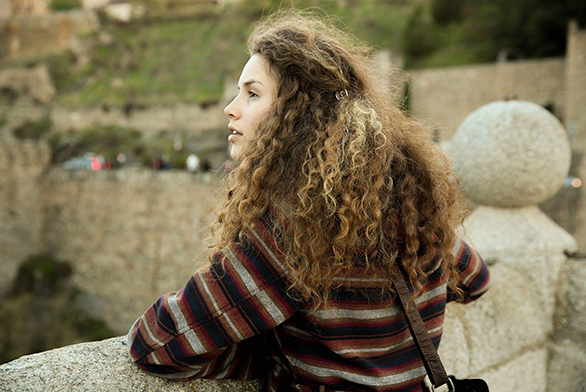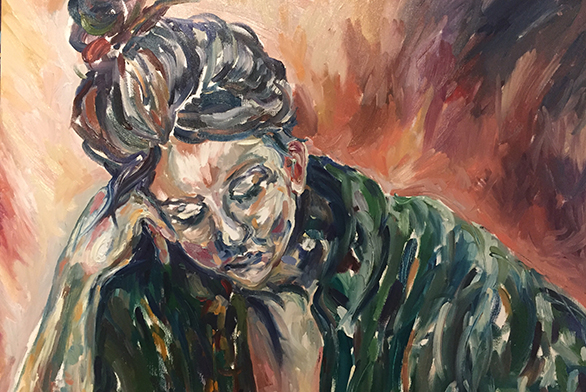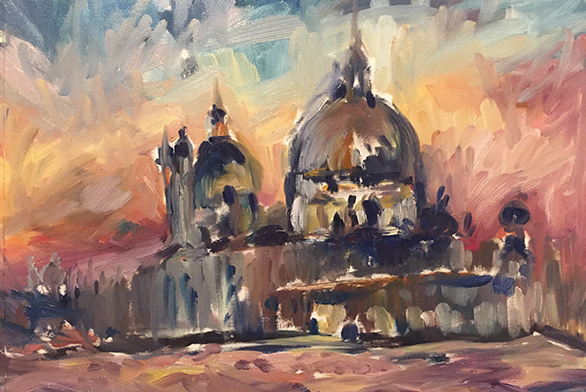Objective Subjects: Portraits of Johnnies Abroad
April 21, 2017 | By Andrew Wice

Though painter Miranda Blas (SF15) will soon leave behind the motionless, gauzy, translucent light of Aix-en-Provence in the South of France, her attempts to capture that light’s true nature have been preserved on canvas.
In the course of acquiring a master of fine arts degree from the Marchutz School of Fine Arts, Blas’s portfolio now features a unique series of oil paintings: portraits of St. John’s undergraduates during their study abroad in Aix-en-Provence.
These students are following the path Blas herself began only two years ago. Upon graduating from St. John’s College, Blas moved to France to join the summer program of the Marchutz School, part of the Institute for American Universities in Aix-en-Provence, where the study abroad program is now being conducted.
As an undergraduate, Blas received a Pathways Fellowship, which provides funding for St. John’s students to obtain any special coursework they might need to pursue their graduate studies. After the conclusion of that summer program, Blas was offered a scholarship to join the inaugural class of the Marchutz School’s brand-new masters program.
Blas’s oblique route to an MFA was not always her plan. A native of Colorado and a dedicated artist, she originally went to Santa Fe to visit an undergraduate art school.
“But as soon as I walked onto the St. John’s campus and learned about the Program there, I decided to go to St. John’s,” she says. “I walked up to the placita and I saw the koi pond, and I just felt this sense of already being at home. … Northern New Mexico is special. You feel part of something bigger there.”
Blas accepted the sacrifice of attending a college that lacked a formal fine arts program in exchange for acquiring an interdisciplinary education, which broadened her perspective and instilled an exactitude for her studies. As an illustration of this intellectual cross-pollination, it was during a mathematics class that Blas learned about the Marchutz fine arts program.

Drawn to the flinty old hills and winding streets of Cézanne’s beloved Aix-en-Provence, the artist Leo Marchutz founded his eponymous art school in 1971. There, Miranda Blas has learned to seek what Cézanne and other great masters sought: the concrete study of nature. Not to reproduce nature, but to represent it; not to imitate Cézanne, but to adopt the rigor of his inquiry. This principle was familiar, and one which she had already embraced.
“Return to the original source, the original author, look at the original text—in the same way we do that at St. John’s, we go to nature at Marchutz,” she explains. “You go into the landscape and you set up your easel in a field and you paint the Sainte-Victoire, the mountain that Cézanne painted over and over again. You come into contact with that original source. It’s fruitful in much the same way, and it’s unforgiving in much the same way that a text like Newton is. You have to work to get it. It’s a study of nature.”
The relationship between St. John’s College and the Marchutz School goes back over 40 years. The art school’s assistant dean, John Gasparach, is a St. John’s College alumnus (SFGI03) who studied at the very first Marchutz School summer session in 1972.
Gasparach notes the pedagogical parallels between the St. John’s Program and the Marchutz School’s philosophy, which features “an integral study of art history, art criticism and the practice of painting and drawing. There is equal emphasis on the continuing study of masterworks of all periods—from the cave paintings of Lascaux to the late portraits by Giacometti—along with an enduring attempt to grasp and render one’s vision of nature.”
The results of Blas’s investigations are revealed in her richly textured oil paintings. Physical objects and transitive light are signified by short brushstrokes of broken color. She seeks to extract the furtive, inner nature of each subject, and make a meticulous impression of its soul. Blas maps this depth onto a two-dimensional canvas, she says, “to represent and recreate the volume of the person in front of me.”
Gasparach describes Blas’s work as “both highly passionate, formed from intense contrasts of shadow and light, as well as full of a lived reason and rigor. She shows herself able to step beyond what she already knows, she takes risks.”

The aspiration Blas remains guided by, “studying nature to say something true about it,” is perhaps best expressed in her series of St. John’s College student portraits. She paints the portraits of Johnnies in Aix while they read one of the canonical great books. It allows Blas access to her subjects’ potential energy and kinetic stillness.
“I enjoy painting people while they’re reading because you really get a sense of their full presence. They’re actively engaged in something, but also sitting still. You can almost feel a buzzing in the air of someone’s thoughts, like an intellectual volume.”
Blas will continue to the next step of her artistic and personal development when she returns to the United States in the autumn of 2017. She remains committed to an objective that every great master would appreciate: “If I can create a painting that says something true and meaningful and beautiful about the world, then that’s a success.”

